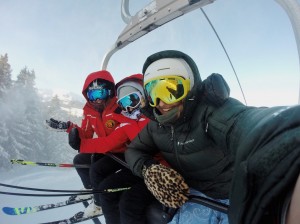Skiing & Snowboarding Safety
Start breaking out your winter gear and head to the slopes. Skiing and snowboarding are two of the most popular winter sports, but they’re also teetering on the line of danger. While you may have heard stories about injuries people have suffered due to skiing, the reality is the rate is only 3 injuries per every 1,000 skiers. On the other side, snowboarding injuries happen between 4 and 16 times per every 1,000 people. While we don’t want to see anyone injured, those numbers seem to be pretty low and prove the sports aren’t as dangerous as they lead on to be! It’s been found that most of the injuries people suffer are due to their own faults. About 75% of the injuries come from falling down or losing control. While at times it’s hard to say when an injury will occur, it’s safe to say being aware of skiing and snowboarding safety tips can only help. Next time you decide to take a skiing or snowboarding trip, make sure safety is your top priority. Should you suffer an injury, direct access physical therapy can help! With no referral needed, physical therapy can help to rectify your winter related injury.
Skiing and Snowboarding tips you should know:
Prior to getting out there, you should be as prepared as possible. To start, you always want to bring the proper gear along. You never know what’s going to come your way, so sometimes bringing that extra gear that’ll keep you safe is necessary. Aside from what you’re wearing, it’s also important you’re healthy and in good shape to participate. The more physically capable you are of skiing or snowboarding, the more enjoyable the experience will be. Other tips that will keep you safe include:
-
Try always to wear a helmet
-
Although it isn’t mandatory to wear one, bringing one along could help you sustain certain injuries.
-
-
Be prepared for all types of weather
-
Layering up will allow you to stay warm, or cool off depending on the day.
-
-
Try to purchase gear that is water and wind-resistant.
-
Extra pairs of socks and gloves are always helpful.
-
Wear goggles.
-
It’s safer to ski or snowboard with friends in case something happens!
-
Stay hydrated and take breaks when you need.
Keep in mind when on the mountain:
There’s no better way to test your abilities then getting on the mountain. While skiing and snowboarding are meant to be fun, it’s important you know exactly what you’re getting into. If you’re not 100% certain on your skills, don’t be ashamed to enroll in a class. The more you practice, the better you’ll get! Being aware of your abilities can only benefit you while heading down the mountain. Especially when it’s time to for quick decision making. Next time you hit the slopes, keep the following in the back of your head:
-
Be aware of your technique to help stay in control.
-
Know the terrain.
-
Be mindful of others around you.
-
Stay mentally and physically present.
-
If you think you can’t handle a slope, leave your skis or snowboard on and side step down the slope instead.
-
If you’re tired, it’s probably time to stop.
Responsibilities that keep you safe:
As a skier or snowboarder, there is a responsibility you have that keeps you and others safe. Being cautious and aware of those around you is beneficial for everyone out on the slopes. Whether you’re skiing or snowboarding, it’s important to uphold the following responsibilities:
-
Stay in control.
-
The skiers or snowboarders ahead of you have the right of way.
-
Remember, when you are starting up downhill or merging, look uphill and yield first.
-
Learn how to use devices that can help prevent any runaway equipment.
-
Never go on a closed trail.
-
Observe all signs and warnings.
-
Use lifts safely, and if you don’t know how then ask!
Following these tips will only make your skiing or snowboarding trip more enjoyable for everyone. Without safety, nobody is having fun, that’s why it’s important to educate yourself before hitting the slopes.
Save Time With Direct Access PT!
Should you suffer an injury, direct access for physical therapy can be an essential tool for your recovery process. Direct access gives patients the ability to seek physical therapy, without the need for a referral from a doctor or another healthcare practitioner. For more information regarding direct access, contact Farmingdale Physical Therapy East today!

